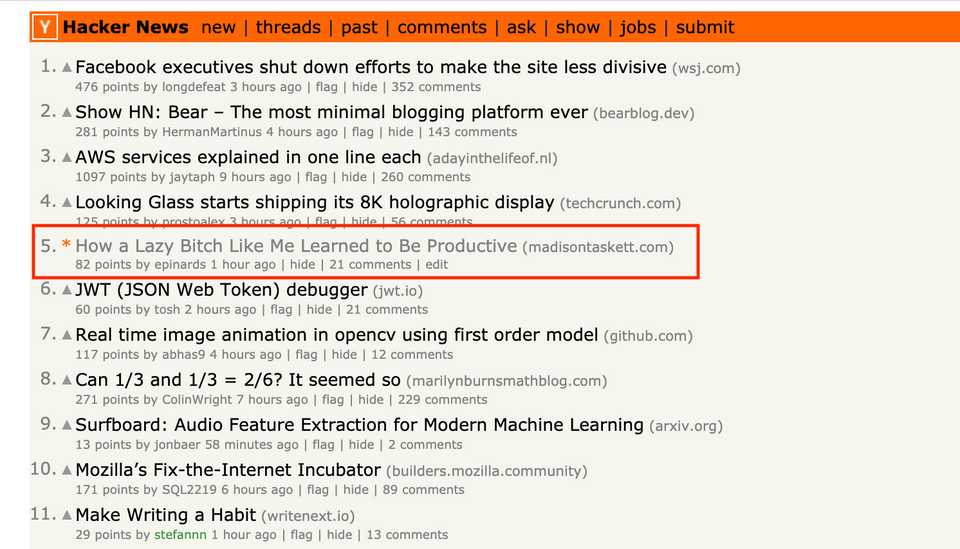How I made the front page of Hacker News on my first try

Two months ago, my personal blog averaged about one and a half visitors each day. Then I made my first submission to Hacker News, it hit the front page, and within five days 20,000 people visited my blog! That's crazy.
So how did my story make it to the front page?
It was all luck. K thanks, bye.
Seriously though, there is always a decent element of luck and randomness in these things. But since 'How a Lazy Bitch like me learned to be Productive' also made the front page of Indie Hackers, it's worth looking into the components that made the Lazy Bitch Productivity piece so up-voteable.
Why was it successful?

Whoever told you to never judge a book by its cover was just bitter that no one would read their content. People 100% judge a piece by it's 'cover', or headline; we all know this deep down. Our brains are our spam filters, and 99% of information we see, we just ignore. If your post doesn't stand out right away, it'll forever get lost in the noise.
HN is all about the title.

Let's break down what made the title, 'How a Lazy Bitch like me learned to be Productive,' a success. I highlighted a subject HN readers would be interested in (productivity) and I added in:
- something that's 'common knowledge' and flipped it on its head. Lazy and productive don't go together, and it's assumed you can't be one and the other at the same time. Our brains respond to contrast and novelty. This title provides both at the same time. I also used this same technique with a conference talk titled 'Why Your Content Sucks (Hint: it's not a Messaging Problem, it's a Psychology problem).' At the time, everyone in the marketing community kept saying, 'it's a messaging problem,' when their strategies failed, so I called them out on it. It became the most RSVPed talk of the 200-event conference due mostly to the title.
- a personal story. We're hardwired to respond to ideas in the form of first-person stories; it makes it easier for us to insert ourselves into the concept and really bring it to life. I could have titled this 'The Lazy Bitch Approach to Productivity', but it doesn't sound as good as 'How a Lazy Bitch like me learned to be Productive' does it? It needs that human aspect to bring it to life and start to paint a picture in your mind before you even click on the link.
- personality. There are thousands of productivity articles out there that all sound exactly the same, because the writer was afraid of alienating anyone and they used language that appeals to 'everyone' (aka no one). Using the word bitch made this title stand out. People want to read something that sounds like it was written by a real human. I wasn't afraid to have some fun, and it paid off.
Obviously, this title only worked in places that were okay with profanity. I tried this title on LinkedIn and it got a lot of views but no likes or comments because no one on LI wants to associate with a post that has 'bitch' in the title.
Note: A good title doesn't need to include these aspects in order to be click worthy, but this is what worked for me for this particular subject.
Oh yeah, and the article was good too.
But don't forget, the article could have been the best thing since sliced bread, and if it had a bad title, no one would have ever found out. It's always worth it to spend a lot of time on your title.
The Article:
- Starts off with a large transformation. Our brains are spam filters, and one way to get marked 'priority' by someone's mind is to provide a lot of contrast (just like I showed you earlier in this post). Showing a lazy bitch stuffing her face on the couch, then having her morph into a slightly less creepy version of Patrick Bateman, provides a really stark change and gets you excited to make a transformation yourself. I used contrast at the beginning of this article for the same reason.
- Is made with love. When you love your people and that love comes through in the content, they recognize that as quality. This shift in intention has a huge impact on how I write, and leads to me writing more actionable, useful articles.
- Is playful AF. Instead of publishing the Lazy Bitch article right away, I waited until I was in a really happy, fun, playful mood and went back and edited everything in that voice (I also chose the title then).
- I made it half as long as the original draft. When I'm reading back a draft, I look for the places where my attention starts to wander. Then I ruthlessly cut out those parts. When in doubt, take it out.
And that's it! To quickly recap: make a good, actionable article but spend all your time on the title. Now go get 'em, Tiger!